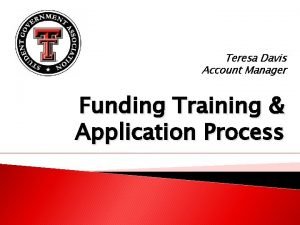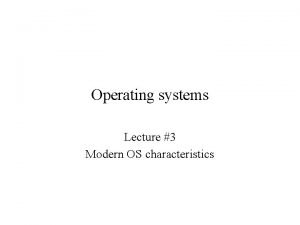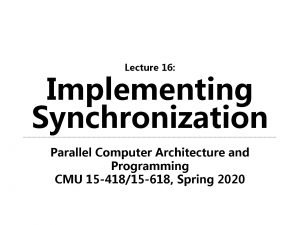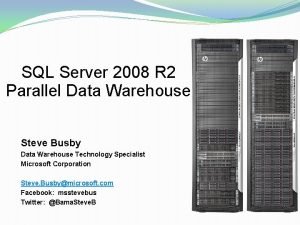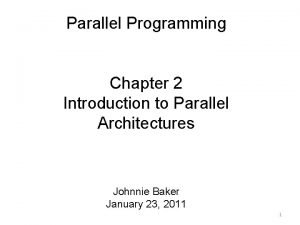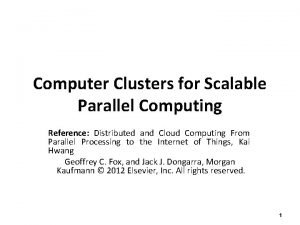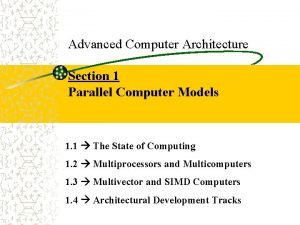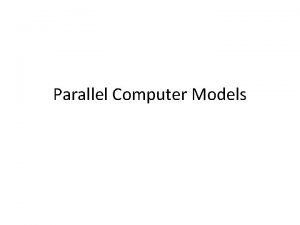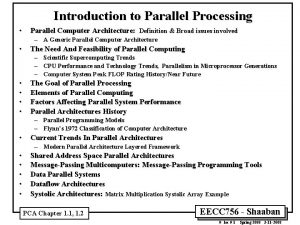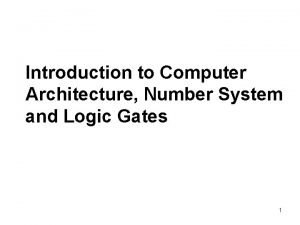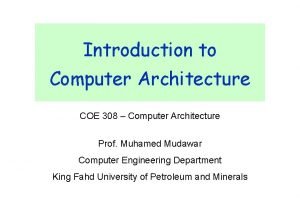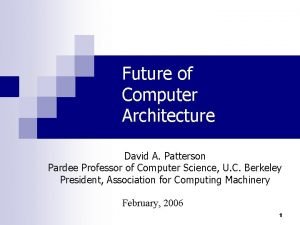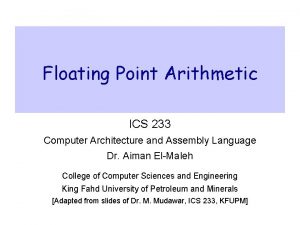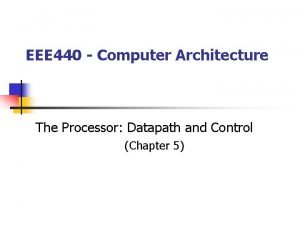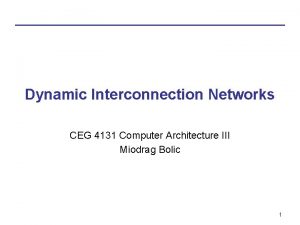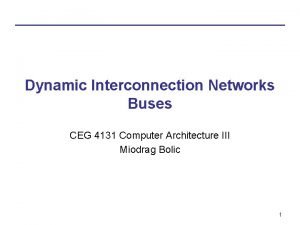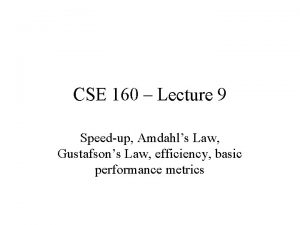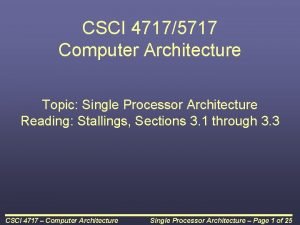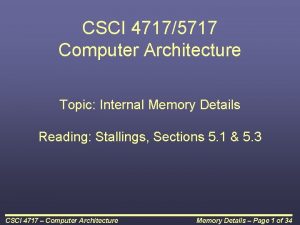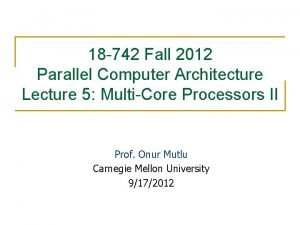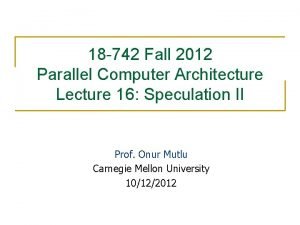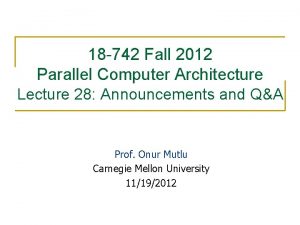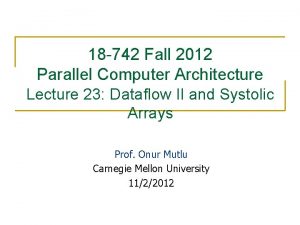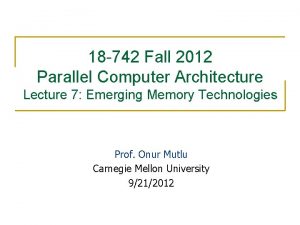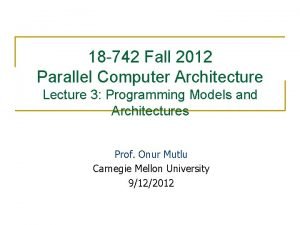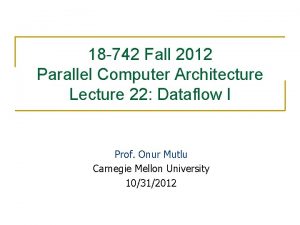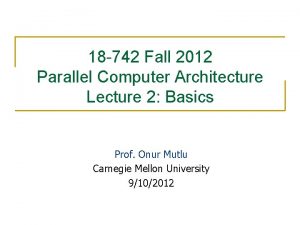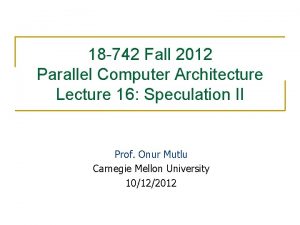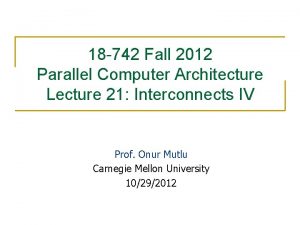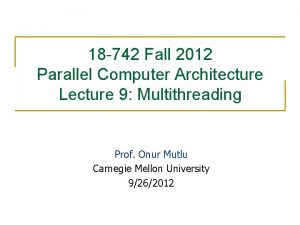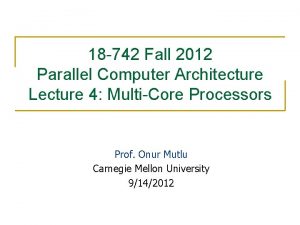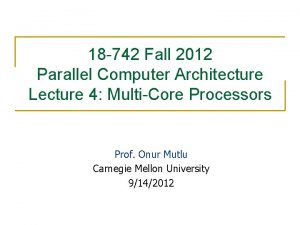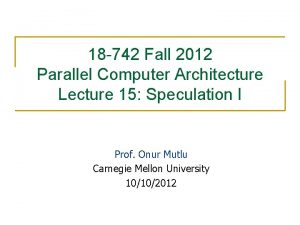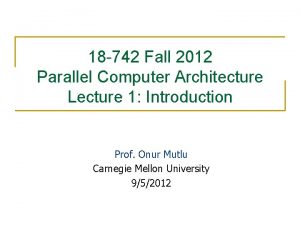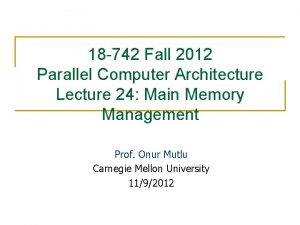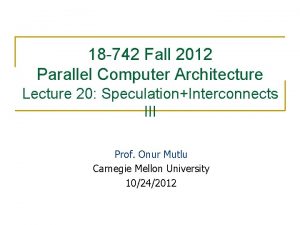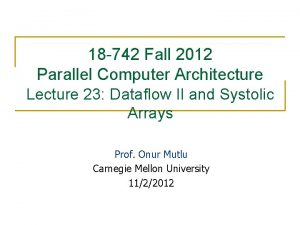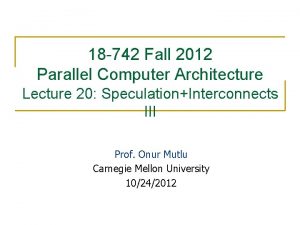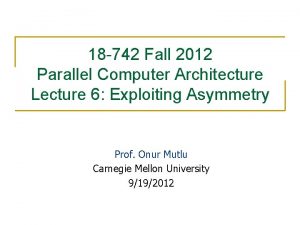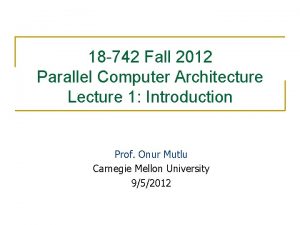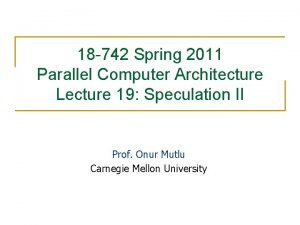18 742 Fall 2012 Parallel Computer Architecture Lecture











































































- Slides: 75

18 -742 Fall 2012 Parallel Computer Architecture Lecture 5: Multi-Core Processors II Prof. Onur Mutlu Carnegie Mellon University 9/17/2012

New Review Assignments n n n Due: Friday, September 21, 11: 59 pm. Smith, “Architecture and applications of the HEP multiprocessor computer system, ” SPIE 1981. Tullsen et al. , “Exploiting Choice: Instruction Fetch and Issue on an Implementable Simultaneous Multithreading Processor, ” ISCA 1996. Chappell et al. , “Simultaneous Subordinate Microthreading (SSMT), ” ISCA 1999. Reinhardt and Mukherjee, “Transient Fault Detection via Simultaneous Multithreading, ” ISCA 2000. 2

Last Lecture: Multi-Core Alternatives n n n Bigger, more powerful single core Bigger caches (Simultaneous) multithreading Integrate platform components on chip instead More scalable superscalar, out-of-order engines Traditional symmetric multiprocessors Dataflow? Vector processors (SIMD)? Integrating DRAM on chip? Reconfigurable logic? (general purpose? ) Other alternatives? 3

Today n An Early History of Multi-Core n Homogeneous Multi-Core Evolution n From Symmetry to Asymmetry 4

Multi-Core Evolution (An Early History) 5

Piranha Chip Multiprocessor n Barroso et al. , “Piranha: A Scalable Architecture Based on Single. Chip Multiprocessing, ” ISCA 2000. n An early example of a symmetric multi-core processor Large-scale server based on CMP nodes Designed for commercial workloads n Read: n n q q Barroso et al. , “Memory System Characterization of Commercial Workloads, ” ISCA 1998. Ranganathan et al. , “Performance of Database Workloads on Shared-Memory Systems with Out-of-Order Processors, ” ASPLOS 1998.

Commercial Workload Characteristics n Memory system is the main bottleneck q q n Very poor Instruction Level Parallelism (ILP) with existing techniques q q q n Very high CPI Execution time dominated by memory stall times Instruction stalls as important as data stalls Fast/large L 2 caches are critical Frequent hard-to-predict branches Large L 1 miss ratios Small gains from wide-issue out-of-order techniques No need for floating point and multimedia units 7

Piranha Processing Node CPU Alpha core: 1 -issue, in-order, 500 MHz Next few slides from Luiz Barroso’s ISCA 2000 presentation of Piranha: A Scalable Architecture Based on Single-Chip Multiprocessing

Piranha Processing Node CPU I$ D$ Alpha core: 1 -issue, in-order, 500 MHz L 1 caches: I&D, 64 KB, 2 -way

Piranha Processing Node CPU CPU I$ D$ Alpha core: 1 -issue, in-order, 500 MHz L 1 caches: I&D, 64 KB, 2 -way Intra-chip switch (ICS) 32 GB/sec, 1 -cycle delay ICS I$ D$ CPU CPU

Piranha Processing Node CPU I$ D$ CPU L 2$ I$ D$ L 2$ ICS L 2$ I$ D$ CPU Alpha core: 1 -issue, in-order, 500 MHz L 1 caches: I&D, 64 KB, 2 -way Intra-chip switch (ICS) 32 GB/sec, 1 -cycle delay L 2 cache: shared, 1 MB, 8 -way

Piranha Processing Node MEM-CTL CPU I$ D$ CPU L 2$ I$ D$ L 2$ ICS L 2$ I$ D$ CPU CPU MEM-CTL 8 banks @1. 6 GB/sec Alpha core: 1 -issue, in-order, 500 MHz L 1 caches: I&D, 64 KB, 2 -way Intra-chip switch (ICS) 32 GB/sec, 1 -cycle delay L 2 cache: shared, 1 MB, 8 -way Memory Controller (MC) RDRAM, 12. 8 GB/sec

Piranha Processing Node MEM-CTL CPU HE I$ D$ CPU L 2$ I$ D$ L 2$ ICS RE L 2$ I$ D$ CPU CPU MEM-CTL Alpha core: 1 -issue, in-order, 500 MHz L 1 caches: I&D, 64 KB, 2 -way Intra-chip switch (ICS) 32 GB/sec, 1 -cycle delay L 2 cache: shared, 1 MB, 8 -way Memory Controller (MC) RDRAM, 12. 8 GB/sec Protocol Engines (HE & RE) prog. , 1 K instr. , even/odd interleaving

Piranha Processing Node MEM-CTL 4 Links @ 8 GB/s CPU I$ D$ L 2$ I$ D$ Router HE CPU L 2$ I$ D$ L 2$ ICS RE L 2$ I$ D$ CPU CPU MEM-CTL Alpha core: 1 -issue, in-order, 500 MHz L 1 caches: I&D, 64 KB, 2 -way Intra-chip switch (ICS) 32 GB/sec, 1 -cycle delay L 2 cache: shared, 1 MB, 8 -way Memory Controller (MC) RDRAM, 12. 8 GB/sec Protocol Engines (HE & RE): prog. , 1 K instr. , even/odd interleaving System Interconnect: 4 -port Xbar router topology independent 32 GB/sec total bandwidth

Piranha Processing Node MEM-CTL CPU I$ D$ L 2$ I$ D$ Router HE CPU L 2$ I$ D$ L 2$ ICS RE L 2$ I$ D$ CPU CPU MEM-CTL Alpha core: 1 -issue, in-order, 500 MHz L 1 caches: I&D, 64 KB, 2 -way Intra-chip switch (ICS) 32 GB/sec, 1 -cycle delay L 2 cache: shared, 1 MB, 8 -way Memory Controller (MC) RDRAM, 12. 8 GB/sec Protocol Engines (HE & RE): prog. , 1 K instr. , even/odd interleaving System Interconnect: 4 -port Xbar router topology independent 32 GB/sec total bandwidth

Piranha Processing Node 16

Inter-Node Coherence Protocol Engine 17

Piranha System 18

Piranha I/O Node 19

Sun Niagara (Ultra. SPARC T 1) n Kongetira et al. , “Niagara: A 32 -Way Multithreaded SPARC Processor, ” IEEE Micro 2005. 20

Niagara Core n n n 4 -way fine-grain multithreaded, 6 -stage, dual-issue in-order Round robin thread selection (unless cache miss) Shared FP unit among cores 21

Niagara Design Point n Also designed for commercial applications 22

Sun Niagara II (Ultra. SPARC T 2) n 8 SPARC cores, 8 threads/core. 8 stages. 16 KB I$ per Core. 8 KB D$ per Core. FP, Graphics, Crypto, units per Core. n 4 MB Shared L 2, 8 banks, 16 way set associative. n 4 dual-channel FBDIMM memory controllers. n X 8 PCI-Express @ 2. 5 Gb/s. n Two 10 G Ethernet ports @ 3. 125 Gb/s. 23

Chip Multithreading (CMT) n n Spracklen and Abraham, “Chip Multithreading: Opportunities and Challenges, ” HPCA Industrial Session, 2005. Idea: Chip multiprocessor where each core is multithreaded q q n Niagara 1/2: fine grained multithreading IBM POWER 5: simultaneous multithreading Motivation: Tolerate memory latency better q q A simple core stays idle on a cache miss Multithreading enables tolerating cache miss latency when there is TLP 24

CMT (CMP + MT) vs. CMP n Advantages of adding multithreading to each core + Better memory latency tolerance when there are enough threads + Fine grained multithreading can simplify core design (no need for branch prediction, dependency checking) + Potentially better utilization of core, cache, memory resources + Shared instructions and data among threads not replicated + When one thread is not using a resource, another can n Disadvantages - Reduced single-thread performance (a thread does not have the core and L 1 caches to itself) - More pressure on the shared resources (cache, off-chip bandwidth) more resource contention - Applications with limited TLP do not benefit 25

Sun ROCK n n n Chaudhry et al. , “Rock: A High-Performance Sparc CMT Processor, ” IEEE Micro, 2009. Chaudhry et al. , “Simultaneous Speculative Threading: A Novel Pipeline Architecture Implemented in Sun's ROCK Processor, ” ISCA 2009 Goals: q q n Maximize throughput when threads are available Boost single-thread performance when threads are not available and on cache misses Ideas: q q Runahead on a cache miss ahead thread executes missindependent instructions, behind thread executes dependent instructions Branch prediction (gshare) 26

Sun ROCK n n 16 cores, 2 threads per core (fewer threads than Niagara 2) 4 cores share a 32 KB instruction cache 2 cores share a 32 KB data cache 2 MB L 2 cache (smaller than Niagara 2) 27

Runahead Execution (I) n A simple pre-execution method for prefetching purposes Mutlu et al. , “Runahead Execution: An Alternative to Very Large Instruction Windows for Out-of-order Processors, ” HPCA 2003. n When the oldest instruction is a long-latency cache miss: n q n In runahead mode: q q q n Checkpoint architectural state and enter runahead mode Speculatively pre-execute instructions The purpose of pre-execution is to generate prefetches L 2 -miss dependent instructions are marked INV and dropped Runahead mode ends when the original miss returns q Checkpoint is restored and normal execution resumes 28

Runahead Execution (II) Small Window: Load 2 Miss Load 1 Miss Compute Stall Compute Miss 1 Stall Miss 2 Runahead: Load 1 Miss Compute Load 2 Miss Runahead Miss 1 Load 1 Hit Load 2 Hit Compute Saved Cycles Miss 2 29

Runahead Execution (III) n Advantages + Very accurate prefetches for data/instructions (all cache levels) + Follows the program path + Simple to implement, most of the hardware is already built in n Disadvantages -- Extra executed instructions n Limitations -- Limited by branch prediction accuracy -- Cannot prefetch dependent cache misses. Solution? -- Effectiveness limited by available Memory Level Parallelism n Mutlu et al. , “Efficient Runahead Execution: Power-Efficient Memory Latency Tolerance, ” IEEE Micro Jan/Feb 2006. 30

Performance of Runahead Execution 31

Sun ROCK Cores n n Load miss in L 1 cache starts parallelization using 2 HW threads Ahead thread q q q n Behind thread q n Executes deferred instructions and re-defers them if necessary Memory-Level Parallelism (MLP) q n Checkpoints state and executes speculatively Instructions independent of load miss are speculatively executed Load miss(es) and dependent instructions are deferred to behind thread Run ahead on load miss and generate additional load misses Instruction-Level Parallelism (ILP) q Ahead and behind threads execute independent instructions from different points in program in parallel 32

ROCK Pipeline 33

More Powerful Cores in Sun ROCK n Advantages + Higher single-thread performance (MLP + ILP) + Better cache miss tolerance Can reduce on-chip cache sizes n Disadvantages - Bigger cores Fewer cores Lower parallel throughput (in terms of threads). How about each thread’s response time? - More complex than Niagara cores (but simpler than conventional out-of-order execution) Longer design time? 34

More Powerful Cores in Sun ROCK n Chaudhry talk, Aug 2008. 35

More Powerful Cores in Sun ROCK n Chaudhry et al. , “Simultaneous Speculative Threading: A Novel Pipeline Architecture Implemented in Sun's ROCK Processor, ” ISCA 2009 36

IBM POWER 4 n n n Tendler et al. , “POWER 4 system microarchitecture, ” IBM J R&D, 2002. Another symmetric multi-core chip… But, fewer and more powerful cores 37

IBM POWER 4 n n n 2 cores, out-of-order execution 100 -entry instruction window in each core 8 -wide instruction fetch, issue, execute Large, local+global hybrid branch predictor 1. 5 MB, 8 -way L 2 cache Aggressive stream based prefetching 38

IBM POWER 5 n Kalla et al. , “IBM Power 5 Chip: A Dual-Core Multithreaded Processor, ” IEEE Micro 2004. 39

IBM POWER 6 n n n Le et al. , “IBM POWER 6 microarchitecture, ” IBM J R&D, 2007. 2 cores, in order, high frequency (4. 7 GHz) 8 wide fetch Simultaneous multithreading in each core Runahead execution in each core q Similar to Sun ROCK 40

IBM POWER 7 n n n Kalla et al. , “Power 7: IBM’s Next-Generation Server Processor, ” IEEE Micro 2010. 8 out-of-order cores, 4 -way SMT in each core Turbo. Core mode q Can turn off cores so that other cores can be run at higher frequency 41

Large vs. Small Cores Large Core Out-of-order Wide fetch e. g. 4 -wide Deeper pipeline Aggressive branch predictor (e. g. hybrid) • Multiple functional units • Trace cache • Memory dependence speculation • • Small Core • • In-order Narrow Fetch e. g. 2 -wide Shallow pipeline Simple branch predictor (e. g. Gshare) • Few functional units Large Cores are power inefficient: e. g. , 2 x performance for 4 x area (power) 42

Large vs. Small Cores n Grochowski et al. , “Best of both Latency and Throughput, ” ICCD 2004. 43

Tile-Large Approach Large core “Tile-Large” Tile a few large cores n IBM Power 5, AMD Barcelona, Intel Core 2 Quad, Intel Nehalem + High performance on single thread, serial code sections (2 units) - Low throughput on parallel program portions (8 units) n 44

Tile-Small Approach Small core Small core Small core Small core “Tile-Small” Tile many small cores n Sun Niagara, Intel Larrabee, Tilera TILE (tile ultra-small) + High throughput on the parallel part (16 units) - Low performance on the serial part, single thread (1 unit) n 45

Can We Get the Best of Both worlds? n Tile Large + High performance on single thread, serial code sections (2 units) - Low throughput on parallel program portions (8 units) n Tile Small + High throughput on the parallel part (16 units) - Low performance on the serial part, single thread (1 unit), reduced single-thread performance compared to existing single thread processors n Idea: Have both large and small on the same chip Performance asymmetry 46

Asymmetric Chip Multiprocessor (ACMP) Large core “Tile-Large” Small core Small core Small core Small core Small core “Tile-Small” Small core Small core Small core Large core ACMP Provide one large core and many small cores + Accelerate serial part using the large core (2 units) + Execute parallel part on all cores for high throughput (14 units) n 47

Accelerating Serial Bottlenecks Single thread Large core Small core Small core Small core ACMP Approach 48

Performance vs. Parallelism Assumptions: 1. Small core takes an area budget of 1 and has performance of 1 2. Large core takes an area budget of 4 and has performance of 2 49

ACMP Performance vs. Parallelism Area-budget = 16 small cores Large core Small Small core core Large core Small core core Small Small Small Small core core core “Tile-Small” ACMP “Tile-Large” Large Cores 4 0 1 Small Cores 0 16 12 Serial Performance 2 1 2 2 x 4=8 1 x 16 = 16 1 x 2 + 1 x 12 = 14 Parallel Throughput 50 50

Some Analysis n n n Hill and Marty, “Amdahl’s Law in the Multi-Core Era, ” IEEE Computer 2008. Each Chip Bounded to N BCEs (Base Core Equivalents) One R-BCE Core leaves N-R BCEs Use N-R BCEs for N-R Base Cores Therefore, 1 + N - R Cores per Chip For an N = 16 BCE Chip: Symmetric: Four 4 -BCE cores Asymmetric: One 4 -BCE core & Twelve 1 -BCE base cores 51

Amdahl’s Law Modified n Serial Fraction 1 -F same, so time = (1 – F) / Perf(R) n Parallel Fraction F q q q n One core at rate Perf(R) N-R cores at rate 1 Parallel time = F / (Perf(R) + N - R) Therefore, w. r. t. one base core: 1 Asymmetric Speedup = 1 -F Perf(R) + N - R 52

Asymmetric Multicore Chip, N = 256 BCEs n Number of Cores = 1 (Enhanced) + 256 – R (Base) 53

Symmetric Multicore Chip, N = 256 BCEs Recall F=0. 9, R=28, Cores=9, Speedup=26. 7 54

Asymmetric Multicore Chip, N = 256 BCEs F=0. 99 R=41 (vs. 3) Cores=216 (vs. 85) Speedup=166 (vs. 80) F=0. 9 R=118 (vs. 28) Cores= 139 (vs. 9) Speedup=65. 6 (vs. 26. 7) n Asymmetric multi-core provides better speedup than symmetric multi-core when N is large 55

Asymmetric vs. Symmetric Cores n Advantages of Asymmetric + Can provide better performance when thread parallelism is limited + Can be more energy efficient + Schedule computation to the core type that can best execute it n Disadvantages - Need to design more than one type of core. Always? - Scheduling becomes more complicated - What computation should be scheduled on the large core? - Who should decide? HW vs. SW? - Managing locality and load balancing can become difficult if threads move between cores (transparently to software) - Cores have different demands from shared resources 56

How to Achieve Asymmetry n Static q q Type and power of cores fixed at design time Two approaches to design “faster cores”: n n q n High frequency Build a more complex, powerful core with entirely different uarch Is static asymmetry natural? (chip-wide variations in frequency) Dynamic q q Type and power of cores change dynamically Two approaches to dynamically create “faster cores”: n n n Boost frequency dynamically (limited power budget) Combine small cores to enable a more complex, powerful core Is there a third, fourth, fifth approach? 57

Asymmetry via Boosting of Frequency n Static q q n Due to process variations, cores might have different frequency Simply hardwire/design cores to have different frequencies Dynamic q q Annavaram et al. , “Mitigating Amdahl’s Law Through EPI Throttling, ” ISCA 2005. Dynamic voltage and frequency scaling 58

EPI Throttling n n Goal: Minimize execution time of parallel programs while keeping power within a fixed budget For best scalar and throughput performance, vary energy expended per instruction (EPI) based on available parallelism q q n P = EPI • IPS P = fixed power budget EPI = energy per instruction IPS = aggregate instructions retired per second Idea: For a fixed power budget q q Run sequential phases on high-EPI processor Run parallel phases on multiple low-EPI processors 59

EPI Throttling via DVFS n DVFS: Dynamic voltage frequency scaling n In phases of low thread parallelism q n Run a few cores at high supply voltage and high frequency In phases of high thread parallelism q Run many cores at low supply voltage and low frequency 60

Possible EPI Throttling Techniques n Grochowski et al. , “Best of both Latency and Throughput, ” ICCD 2004. 61

Boosting Frequency of a Small Core vs. Large Core n n Frequency boosting implemented on Intel Nehalem, IBM POWER 7 Advantages of Boosting Frequency + Very simple to implement; no need to design a new core + Parallel throughput does not degrade when TLP is high + Preserves locality of boosted thread n Disadvantages - Does not improve performance if thread is memory bound - Does not reduce Cycles per Instruction (remember the performance equation? ) - Changing frequency/voltage can take longer than switching to a large core 62

We did not cover the following slides in lecture. These are for your preparation for the next lecture.

EPI Throttling (Annavaram et al. , ISCA’ 05) n Static AMP q q q n Duty cycles set once prior to program run Parallel phases run on 3 P/1. 25 GHz Sequential phases run on 1 P/2 GHz Affinity guarantees sequential on 1 P and parallel on 3 Benchmarks that rapidly transition between sequential and parallel phases Dynamic AMP q q Duty cycle changes during program run Parallel phases run on all or a subset of four processors Sequential phases of execution on 1 P/2 GHz Benchmarks with long sequential and parallel phases 64

EPI Throttling (Annavaram et al. , ISCA’ 05) n Evaluation on Base SMP: 4 -way 2 GHz Xeon, 2 MB L 3, 4 GB Memory n Hand-modified programs q q q OMP threads set to 3 for static AMP Calls to set affinity in each thread for static AMP Calls to change duty cycle and to set affinity in dynamic AMP 65

EPI Throttling (Annavaram et al. , ISCA’ 05) n Frequency boosting AMP improves performance compared to 4 -way SMP for many applications 66

EPI Throttling n n Why does Frequency Boosting (FB) AMP not always improve performance? Loss of throughput in static AMP (only 3 processors in parallel portion) q n Rapid transitions between serial and parallel phases q n Is this really the best way of using FB-AMP? Data/thread migration and throttling overhead Boosting frequency does not help memory-bound phases 67

Review So Far n Symmetric Multicore q q q n Evolution of Sun’s and IBM’s Multicore systems and design choices Niagara, Niagara 2, ROCK IBM POWERx Asymmetric multicore q q Motivation Functional vs. Performance Asymmetry Static vs. Dynamic Asymmetry EPI Throttling 68

Design Tradeoffs in ACMP (I) n Hardware Design Effort vs. Programmer Effort - ACMP requires more design effort + Performance becomes less dependent on length of the serial part + Can reduce programmer effort: Serial portions are not as bad for performance with ACMP n Migration Overhead vs. Accelerated Serial Bottleneck + Performance gain from faster execution of serial portion - Performance loss when architectural state is migrated/switched in when the master changes n Can be alleviated with multithreading and hidden by long serial portion - Serial portion incurs cache misses when it needs data generated by the parallel portion - Parallel portion incurs cache misses when it needs data generated by the serial portion 69

Design Tradeoffs in ACMP (II) n Fewer threads vs. accelerated serial bottleneck + Performance gain from accelerated serial portion - Performance loss due to unavailability of L threads in parallel portion q q This need not be the case Large core can implement Multithreading to improve parallel throughput As the number of cores (threads) on chip increases, fractional loss in parallel performance decreases 70

Uses of Asymmetry n So far: q n Improvement in serial performance (sequential bottleneck) What else can we do with asymmetry? q q q Energy reduction? Energy/performance tradeoff? Improvement in parallel portion? 71

Use of Asymmetry for Energy Efficiency Kumar et al. , “Single-ISA Heterogeneous Multi-Core Architectures: The n Potential for Processor Power Reduction, ” MICRO 2003. n Idea: q q q Implement multiple types of cores on chip Monitor characteristics of the running thread (e. g. , sample energy/perf on each core periodically) Dynamically pick the core that provides the best energy/performance tradeoff for a given phase n “Best core” Depends on optimization metric 72

Use of Asymmetry for Energy Efficiency 73

Use of Asymmetry for Energy Efficiency Advantages n + More flexibility in energy-performance tradeoff + Can execute computation to the core that is best suited for it (in terms of energy) n Disadvantages/issues - Incorrect predictions/sampling wrong core reduced performance or increased energy - Overhead of core switching - Disadvantages of asymmetric CMP (e. g. , design multiple cores) - Need phase monitoring and matching algorithms - What characteristics should be monitored? - Once characteristics known, how do you pick the core? 74

Use of ACMP to Improve Parallel Portion Performance n Mutual Exclusion: q n n Threads are not allowed to update shared data concurrently Accesses to shared data are encapsulated inside critical sections Only one thread can execute a critical section at a given time Idea: Ship critical sections to a large core Suleman et al. , “Accelerating Critical Section Execution with Asymmetric Multi-Core Architectures, ” ASPLOS 2009, IEEE Micro Top Picks 2010. 75
 Computer architecture notes
Computer architecture notes Isa computer architecture
Isa computer architecture D.m. 742 del 2017 slide
D.m. 742 del 2017 slide Calculate the density of xenon gas at a pressure of 742
Calculate the density of xenon gas at a pressure of 742 Ttu sga funding
Ttu sga funding Chmod 742
Chmod 742 680 705 in expanded form
680 705 in expanded form 142 984 km in miles
142 984 km in miles 01:640:244 lecture notes - lecture 15: plat, idah, farad
01:640:244 lecture notes - lecture 15: plat, idah, farad Synchronization in computer architecture
Synchronization in computer architecture Example of interrupt in os
Example of interrupt in os Bus architecture in computer organization
Bus architecture in computer organization Microsoft sql server 2012 parallel data warehouse
Microsoft sql server 2012 parallel data warehouse Diff between computer organization and architecture
Diff between computer organization and architecture Design of basic computer in computer architecture
Design of basic computer in computer architecture Parallel and distributed computing lecture notes
Parallel and distributed computing lecture notes Computer security 161 cryptocurrency lecture
Computer security 161 cryptocurrency lecture Computer-aided drug design lecture notes
Computer-aided drug design lecture notes How to find the resultant of two parallel forces
How to find the resultant of two parallel forces It is the inner terminus of fingerprint pattern.
It is the inner terminus of fingerprint pattern. Parallelism rules
Parallelism rules Means?
Means? Parallel structure def
Parallel structure def Shift register truth table
Shift register truth table Parallel structure sentence examples
Parallel structure sentence examples Types of parallel architecture
Types of parallel architecture Parallel and distributed database architecture
Parallel and distributed database architecture Parallel and distributed database architecture
Parallel and distributed database architecture Parallel processing architecture
Parallel processing architecture How to draw line in computer graphics
How to draw line in computer graphics Computer clusters for scalable parallel computing
Computer clusters for scalable parallel computing Parallel computer models
Parallel computer models Parallel projection in computer graphics
Parallel projection in computer graphics 1 crore
1 crore Architecture business cycle activities
Architecture business cycle activities Call and return architecture in software engineering
Call and return architecture in software engineering Architecture
Architecture Product architecture steps
Product architecture steps Computer organization and architecture 10th solution
Computer organization and architecture 10th solution Fast desktop for architecture software
Fast desktop for architecture software Computer organization lab experiments
Computer organization lab experiments Introduction to computer organization and architecture
Introduction to computer organization and architecture Timing and control in computer architecture
Timing and control in computer architecture Evolution and interpretation of computer architecture
Evolution and interpretation of computer architecture Dma controller in computer architecture
Dma controller in computer architecture Floating point division algorithm in computer architecture
Floating point division algorithm in computer architecture Absolute addressing mode in computer architecture
Absolute addressing mode in computer architecture Chordal ring
Chordal ring Smt in computer architecture
Smt in computer architecture Pseudo
Pseudo Collision vector in pipelining
Collision vector in pipelining Instruction format in computer architecture
Instruction format in computer architecture What is nano programming in computer architecture
What is nano programming in computer architecture Microprogram sequencer for a control memory
Microprogram sequencer for a control memory Memory system
Memory system Virtual memory tlb
Virtual memory tlb Difference between linear and nonlinear pipeline processors
Difference between linear and nonlinear pipeline processors Computer architecture definition
Computer architecture definition Computer architecture number system
Computer architecture number system What is computer architecture
What is computer architecture Instruction set architecture
Instruction set architecture Input and output devices of computer
Input and output devices of computer Branch prediction
Branch prediction Computer architecture david patterson
Computer architecture david patterson Single instruction single data
Single instruction single data What is guard bit in computer architecture
What is guard bit in computer architecture Datapath in computer architecture
Datapath in computer architecture Explain virtual memory in computer architecture
Explain virtual memory in computer architecture Computer architecture definition
Computer architecture definition Baseline network in computer architecture
Baseline network in computer architecture Dynamic interconnection network
Dynamic interconnection network Digital design and computer architecture
Digital design and computer architecture Computer architecture
Computer architecture Gustafson's law
Gustafson's law State diagram in computer architecture
State diagram in computer architecture Internal memory in computer architecture
Internal memory in computer architecture




